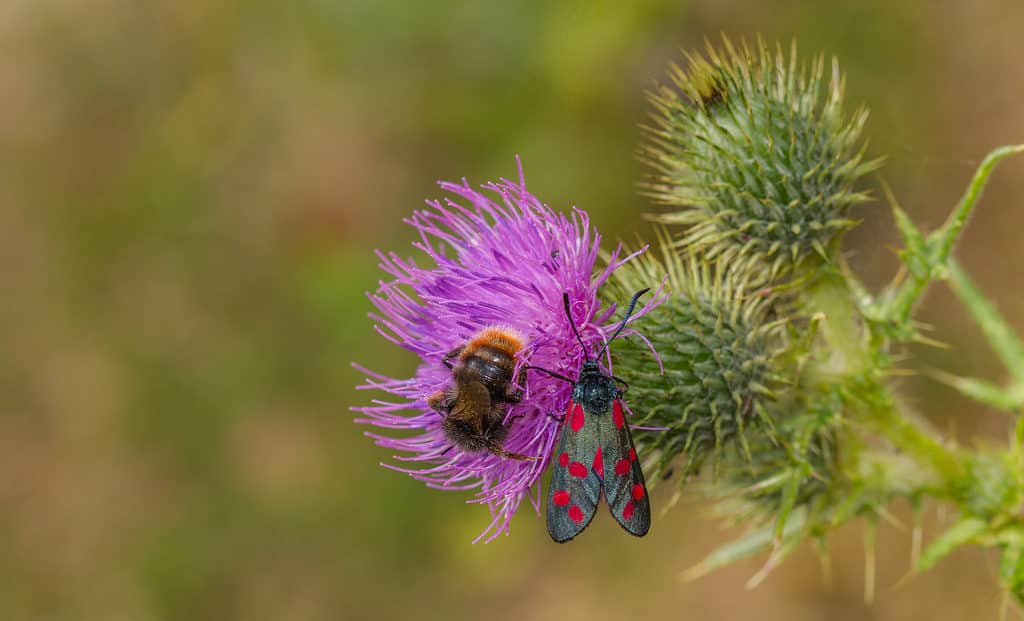Red-Tailed Cuckoo Bumblebee
Bombus rupestris
Red-tailed cuckoo bumblebees do not have the capacity to build their own nests.
Advertisement
Red-Tailed Cuckoo Bumblebee Facts
- Prey
- host nests
- Main Prey
- Bombus lapadarius
- Name Of Young
- larva
- Group Behavior
- Solitary
- Fun Fact
- Red-tailed cuckoo bumblebees do not have the capacity to build their own nests.
- Estimated Population Size
- Undetermined
- Biggest Threat
- habitat loss. pesticide
- Most Distinctive Feature
- size
- Distinctive Feature
- lack of setae (hair)
- Other Name(s)
- N/A
- Gestation Period
- 6-8 days
- Temperament
- solitary, except when usurping a nest
- Wingspan
- 0.75- 1.0 inches
- Training
- N/A
- Optimum pH Level
- N/A
- Incubation Period
- N/A
- Age Of Independence
- 2 weeks
- Age Of Fledgling
- 14 days
- Average Spawn Size
- N/A
- Litter Size
- N/A
- Habitat
- Meadows, moors, and flower gardens
- Predators
- Birds, spiders and other insects
- Diet
- Herbivore
- Average Litter Size
- N/A
- Lifestyle
- Diurnal
- Favorite Food
- nectar
- Type
- Bombus rupestris
- Common Name
- red-tailed cuckoo bumblebee
- Special Features
- ability to kill a queen and usurp her nest.
- Origin
- Europe
- Number Of Species
- 290
- Location
- Europe
- Slogan
- N/A
- Group
- colony,
- Nesting Location
- underground
- Age of Molting
- larva, at various times
Red-Tailed Cuckoo Bumblebee Physical Characteristics
- Color
- Brown
- Black
- Orange
- Skin Type
- Exoskeleton
- Lifespan
- 4-6 months
- Weight
- less than 1 ounce
- Height
- less than 1 inch
- Length
- approximately 1 inch
- Age of Sexual Maturity
- 2-5 days
- Age of Weaning
- N/A
- Venomous
- No
- Aggression
- High
View all of the Red-Tailed Cuckoo Bumblebee images!
Red-tailed cuckoo bumblebees (Bombus rupestris) are a species of cuckoo bumblebees that are native to Europe. They are parasitic, which means they do not have a colony or queen of their own. Instead, they lay their eggs in the nests of other bees. As their larvae develop, they consume the resources intended for the host colony’s offspring. Keep reading to learn more about red-tailed cuckoo bumblebees!
Cuckoo Bumblebees: An overview
Cuckoo bees are parasitic insects that rely on other bees to raise their young. The name is derived from birds in the family Cuculidae, commonly called cuckoo birds, which lay their eggs in the nests of other birds. Cuckoo bees lay parthenogenetic eggs, which do not require fertilization to develop. In general, parthenogenetic eggs produce females.
Cuckoo bees lay their eggs in the nests of similar-looking bee species, by killing the queen. The cuckoo bee then begins masquerading as one of the colony. Once she has been accepted by the colony, she lays her eggs. After their eggs are laid, they leave the nest never to return. The host species raise the cuckoo’s offspring. This is a form of brood parasitism called obligate brood parasitism.
Because cuckoo bees emerge earlier than their hosts, the cuckoo bee larvae consume the resources intended for the host eggs. This often results in the death of host eggs or larvae and can lead to the collapse of the host colony.
Five Facts about Red-Tailed Cuckoo Bumblebees
- Red-tailed cuckoo bumblebees are native to Europe.
- They are known for their distinctive red tail and are often confused with red-tailed bumblebees.
- Red-tailed cuckoo bumblebees do not have the capacity to build their own nests.
- The eggs of red-tailed cuckoo bumblebees hatch before the host’s eggs, allowing the cuckoo bee larvae to consume the host’s food.
- Red-tailed cuckoo bumblebee populations are in decline due to habitat loss, pesticide use, and climate change.
Red-Tailed Cuckoo Bumblebees: Scientific Name
The scientific name for the red-tailed cuckoo bee is Bombus rupestris. The word Bombus is derived from the Latin word for buzzing, which is a characteristic of bumblebees. Rupestris is Latin for rock. Loosely translated, the red-tailed cuckoo bumblebee is a buzzing insect that is found in and around rocks/rock gardens.
Appearance
The red-tailed cuckoo bumblebee is very similar in appearance to the red-tailed bumblebee (Bombus lapadarius). Therefore, Bombus rupestris often utilize the nests of Bombus lapadarius. However, there are a variety of differences between these two species. Red-tailed cuckoo bees (Bombus rupestris) are black/brown bees with orange-to-red tails. The females have to be prepared to fight their way through an angry swarm of workers to get to the queen. Therefore, females of the species are more abundant and larger than males. The females have larger mandibles and thicker, stronger abdomens than host bees.

The red-tailed cuckoo bee (
Bombus rupestris
), left, is a black/brown bee with an orange-to-red tail
©thatmacroguy/Shutterstock.com
Red-tailed cuckoo bumblebees do not have corbiculae (singularly, corbicula), commonly called pollen baskets, for collecting pollen. They also lack the copious leg hairs used for spreading pollen. Cuckoo bumblebees have vestigial wax glands. Though present, they are underdeveloped and non-functional. Wax is an essential component of honeycomb, which in turn is an essential component of a healthy colony. Though not noticeable enough to be discernable to an untrained eye, these differences are at the core of how cuckoo bumblebees differ from their non-parasitic counterparts. Even if they desired to help, evolution has left cuckoo bumblebees bereft of the ability to be helpful.
Red-Tailed Cuckoo Bumblebees: Behavior
They are not part of a colony they do not have a queen. The red-tailed cuckoo bumblebee is a solitary creature. Though they rely on a degree of integration with the host colony, once the red-tailed cuckoo bumblebee has infiltrated a host nest and laid her eggs she leaves, spending the rest of her life flitting from flower to flower drinking nectar and consuming pollen. Cuckoo bumblebees are not great pollinators although they are occasionally accidental pollinators. Lacking the requisite structure to carry or spread pollen, they simply feed on nectar and pollen for the energy and nutrients they provide. Males of the species are not well-studied. There are indications that the males produce pheromones that aid the females in locating appropriate nests.
Habitat
Red-tailed cuckoo bumblebees live in open habitats such as grasslands, meadows, heaths, and moors. They are also frequent visitors to gardens in urban or suburban green spaces. Cockoos typically prefer areas with a diverse array of flowering plants, as they are generalist foragers and feed on a wide variety of nectar and pollen sources. They live at altitudes up to about 6,000 feet above sea level. Their habitat is subjected to human-caused destruction such as urbanization, agriculture and other human activities have resulted in habitat loss and a reduction in food sources, which have led to a decline in population.
Red-Tailed Cuckoo Bumblebees: Diet
Red-tailed cuckoo bumblebees are generalist foragers which means they feed on nectar from a variety of flowering plants, including clover, thistle, and knapweed. They also consume pollen from these plants, which provides them with protein and other nutrients. Cuckoo bumblebees are not finicky eaters, and will feed on whatever is available in their environment. Like regular bumblebees, cuckoos extract nectar from flowers using their long tongues. Because they don’t establish colonies, their sole focus is on foraging for themselves.
Predators
A variety of animals prey on red-tailed cuckoo bumblebees. Some predators include birds, spiders, and other insects. Many species of birds, like the European goldfinch, will eat bumblebees and their larvae. Orb-weavers and other garden spiders will eat bumblebees that fly into their webs. Cuckoo wasps even prey upon cuckoo bumblebees!
Red-Tailed Cuckoo Bumblebees: Threats
Threats They Face
The red-tailed cuckoo bee faces a number of threats, including habitat loss and degradation, pesticide use, and climate change. These factors reduce the availability of foraging areas for the bee, as well as make it more difficult for the bee to find and parasitize host nests. Additionally, the red-tailed cuckoo bee is also at risk from competition and parasitism by other cuckoo bee species.
Threats They Pose
Red-tailed cuckoo bumblebees are a beneficial species in that they control populations of other species of bees. Left unchecked, a host species can increase rapidly. This increase results in overpopulation and competition for resources. In areas with limited food sources, when non-honey-producing species deplete the food supply, honey bees can suffer, and in the direst circumstances, colony collapse may result.
Conservation Status/Population
The IUCN Red List considers the red-tailed cuckoo bumblebee a species of least concern. But their numbers have decreased in recent years due to habitat fragmentation and loss, and pesticide use. Precise estimates related to the population of these parasitic bumblebees are undetermined. This species historically ebbs and flows, but is thought to be in decline. Habitat loss from urbanization and pesticide use in farming are considered the primary culprits.
Lifecycle
The lifecycle of a parasitic bumblebee consists of the female parasitic bumblebee laying her eggs in the nest of a host colony. The eggs hatch into larvae and feed on the host bumblebee’s food stores and, in some cases, the host larvae. The larvae transform into pupae and continue to develop within the host nest. The pupae emerge as adult parasitic bumblebees. And then the cycle repeats. As mentioned earlier, red-tailed cuckoo bumblebees lay parthenogenetic eggs, which do not require fertilization. Cuckoo bumblebees are not a well-documented genus. Very little is known about male cuckoo bumblebees. Some research has determined that the male cuckoo perhaps plays a role in locating a host nest. Other studies suggest that male cuckoos do little more than hatch, feed, and perish.
Up Next:
View all 114 animals that start with RRed-Tailed Cuckoo Bumblebee FAQs (Frequently Asked Questions)
What is a cuckoo bumblebee?
Cuckoo bees are parasitic insects that rely on other bees to raise their young. Cuckoo bees lay their eggs in the nests of similar-looking bee species, by killing the nest’s queen. The cuckoo bee then begins masquerading as one of the colony. Once accepted, she lays her eggs. After their eggs are laid, they leave the nest never to return. The host nest raises the cuckoo’s offspring. This is a form of brood parasitism called obligate brood parasitism.
Are red-tailed cuckoo bumblebees good pollinators?
No! Red-tailed cuckoo bumblebees are not good pollinators. Red-tailed cuckoo bumblebees lack corbiculae (singularly, corbicula), commonly called pollen baskets, for collecting pollen. They also lack the copious leg hairs used for spreading pollen. So, while cuckoos may inadvertently spread some pollen here and there good pollinators they are not.
Do red-tailed cuckoo bumblebees produce wax?
While cuckoo bumblebees have wax glands, they are underdeveloped and non-functional. Therefore, cuckoo bumblebees are incapable of producing wax which is an essential component of honeycomb.
What predators do red-tailed cuckoo bumblebees face?
Red-tailed cuckoo bumblebees, like other bumblebees, are preyed upon by a variety of animals. Some predators include birds, spiders, and other insects. Many species of birds, like the European goldfinch, will eat bumblebees and their larvae. Orb-weavers and other garden spiders will eat bumblebees that fly into their webs. Cuckoo bumblebees are even preyed upon by cuckoo wasps!
Do red-tailed cuckoo bumblebees have any redeeming features?
Yes! In fact, red-tailed cuckoo bumblebees are considered a beneficial species in that they control populations of other species of bees. Left unchecked, a host species can increase rapidly. This increase results in overpopulation and competition for resources. In areas with limited food sources, when non-honey-producing species deplete the food supply, honey bees can suffer, and in the direst circumstances, colony collapse may result. Cuckoo bees can prevent the overpopulation of such species.
Thank you for reading! Have some feedback for us? Contact the AZ Animals editorial team.
Sources
- nhsn.org.uk, Available here: https://www.nhsn.org.uk/species/red-tailed-cuckoo-bee/
- entomologytoday.org, Available here: https://entomologytoday.org/2018/10/29/cuckoo-bumble-bees-cheating-ways/
- mt.gov, Available here: https://agr.mt.gov/_docs/aginclass-docs/K-8Projects-MontanaPollinatorEducationProject/13_Cuckoo_Bee_NR.pdf
- bumblebee.org, Available here: https://www.bumblebee.org/cuckoo.htm
- bumblebeeconservationtrust.urg, Available here: https://www.bumblebeeconservation.org/red-tailed-bumblebees/red-tailed-cuckoo-bumblebee/
- wiki.org, Available here: https://en.wikipedia.org/wiki/Bombus_rupestris

















